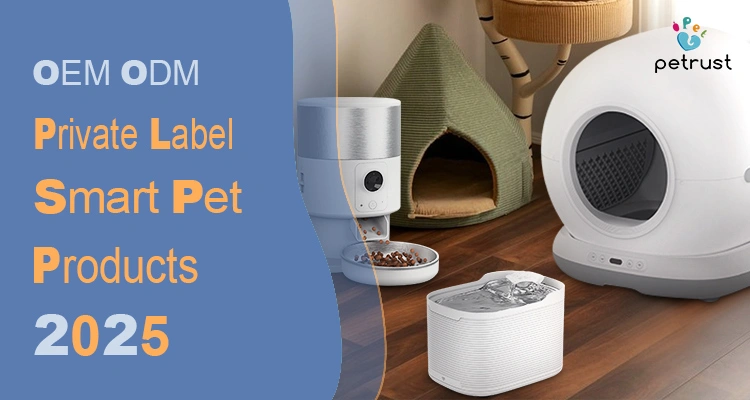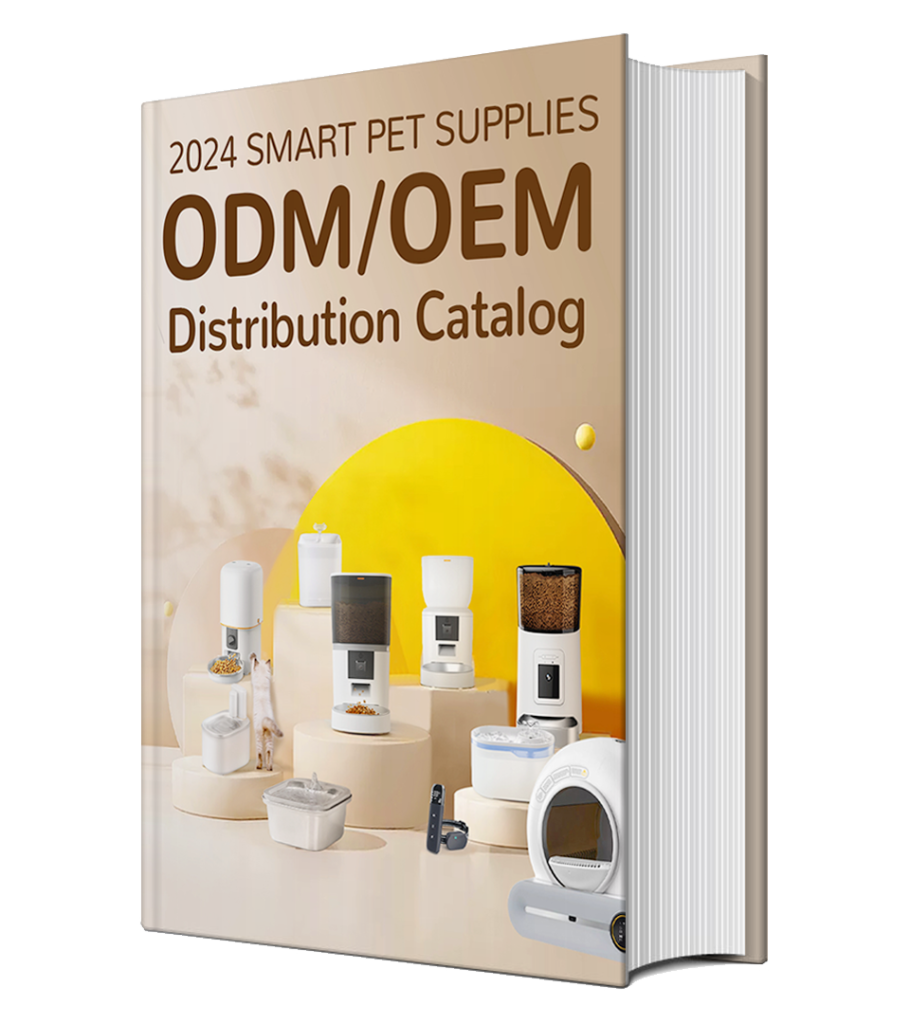The world of OEM ODM private label smart pet products manufacturing is brimming with opportunities for brands, importers, and entrepreneurs ready to meet the growing demand for connected, convenient, and health-focused pet solutions.
Today’s pet owners aren’t just buying products—they’re looking for smart feeders, self-cleaning litter boxes, and water fountains that simplify care, improve pet wellness, and reflect a modern lifestyle.
According to Grand View Research, the global pet care market is projected to grow from $150.6 billion in 2021 to $236.1 billion by 2030, underscoring the booming appetite for innovative smart pet products.
For importers and brand owners, this represents a golden opportunity to offer tailored solutions that resonate with consumers while building a strong, differentiated brand.
Navigating the landscape of OEM, ODM, and private label manufacturing, however, comes with its challenges. Which production model aligns with your goals? How can you balance quality, cost, and compliance?
This guide is designed to answer these questions, providing actionable strategies, practical tips, and industry insights to help you confidently source, customize, and launch smart pet products that capture both market attention and customer loyalty in 2025.
Understanding OEM ODM Private Label Smart Pet Products
Navigating the world of OEM ODM private label smart pet products can feel overwhelming at first, especially when you’re trying to balance innovation, quality, and speed to market.
Understanding the differences between these manufacturing models is essential to making confident decisions that support your brand’s growth, reduce risks, and delight pet owners.
What Does OEM Mean in Smart Pet Product Manufacturing?
OEM, or Original Equipment Manufacturing, allows importers to bring their own product ideas to life according to custom designs and specifications. This model offers flexibility and full creative control, making it ideal for brands aiming to stand out in the competitive smart pet market.
For readers curious about the differences between OEM and ODM, and how to select the best approach for their business, the guide OEM vs ODM Smart Pet Products: Choosing the Right Model in 2025 provides a detailed, step-by-step explanation.
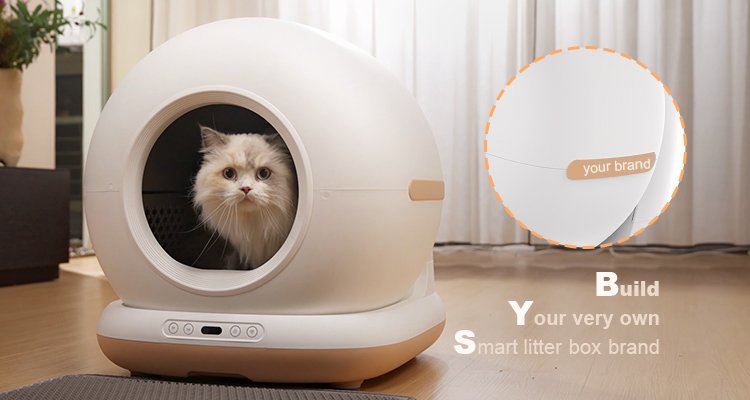
ODM Smart Pet Product Development Explained
ODM, or Original Design Manufacturing, involves working with pre-designed products from factories, with the option to make minor adjustments. This approach is especially appealing for those looking to enter the market quickly, minimize upfront design costs, and test new product concepts with less risk.
How Private Label Smart Pet Product Customization Works
Private label products allow you to brand ready-made products with your logo, packaging, and sometimes small custom touches. This approach is perfect for entrepreneurs or brands wanting a polished product line without investing heavily in design.
For a deeper dive into creating a branded product from factory to shelf, the resource Private Label Smart Pet Products: Building Your Brand from Factory to Shelf offers comprehensive guidance.
Explore Product-Specific OEM/ODM Guides
For importers seeking in-depth, category-focused strategies, several pillar guides provide practical, step-by-step insights into sourcing, customization, and efficient factory selection:
These guides offer actionable strategies for each top smart pet product category, while keeping the bigger picture of OEM, ODM, and private label solutions in view. Following them can help brands and importers navigate the complexities of smart pet product manufacturing with confidence and clarity.
OEM vs ODM vs Private Label – Choosing the Right Smart Pet Product Model
Key Differences Importers Should Know
Understanding the distinctions between OEM, ODM & private label smart pet product models can save time, reduce costly mistakes, and help align your sourcing strategy with your brand goals. Each approach has unique strengths depending on how much control, customization, and speed you need to bring your product to market.
| Feature | OEM | ODM | Private Label |
| Design Control | Full | Partial | Minimal |
| MOQ | High | Medium | Low |
| Custom Features | Any | Limited | None |
| Time to Market | Longer | Moderate | Short |
Pros and Cons of Each Business Model
- OEM: Ideal for brands looking to fully customize product design, functionality, and features. This model allows you to differentiate your offerings and create something truly unique, though it requires more upfront investment and longer production timelines.
- ODM: A balanced option for importers who want faster market entry while retaining some degree of customization. With ODM, you can modify existing products to suit your brand without the higher cost and complexity of full OEM development.
- Private Label: Perfect for smaller retailers or those looking to launch quickly with minimal upfront costs. While the speed to market is a major advantage, differentiation is limited, and competition can be higher in standard product categories.
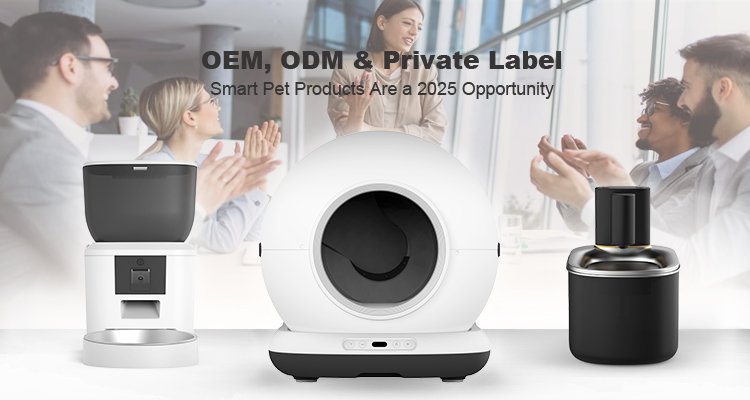
Example: Automatic Pet Feeder OEM vs ODM vs Private Label
- OEM: Imagine a fully custom smart feeder with app integration, voice commands, and a unique compartment design tailored to your brand’s specifications.
- ODM: A pre-designed smart pet feeder that allows minor tweaks—such as aesthetic changes or adding your brand logo—to make it fit your product line.
- Private Label: A ready-made pet feeder you can brand and sell immediately, ideal for testing the market or selling through online stores with lower risk.
Customization Strategies for Importers
When entering the smart pet product market, thoughtful customization can make all the difference. Today’s buyers not only look for convenience and innovation—they also value individuality, design, and sustainability.
By tailoring your products strategically, you can capture attention, strengthen brand identity, and build lasting customer loyalty.
Low MOQ Smart Pet Product OEM Options
For small or emerging brands, low-volume production—typically 50–200 units—offers the freedom to experiment and validate market interest without overextending resources. This approach allows for agile testing of designs, features, and marketing strategies while keeping financial risk minimal.
Explore more insights on Low MOQ Smart Pet Product Factories: Importing Without Large Investment to understand how lean production can accelerate your entry into the market.
Tailored Packaging & Branding Approaches
Packaging and branding are often the first impression a customer experiences. Thoughtful design, color schemes, and logo placement not only communicate quality but also help your product stand out in a crowded marketplace.
For detailed guidance on creating a memorable brand presence through OEM solutions, refer to Tailored Smart Pet Product OEM: How to Stand Out in a Competitive Market.
Adding High-Tech Features (RFID, Cameras, App Control)
Integrating advanced technologies transforms ordinary products into smart, premium offerings. Features like RFID recognition, app-controlled feeding, and AI-driven portion management are becoming standard expectations for pet owners seeking convenience and health benefits.
Industry projections from Market Report Analytics indicate the smart pet product market could reach $4.958 billion by 2025, with a 19.9% CAGR through 2033. Learn practical ways to incorporate these innovations in High-Tech Smart Pet Product OEM: Adding RFID, Cameras & App Control.
Eco-Friendly Smart Pet Product OEM and ODM Choices
Sustainability is no longer optional—consumers increasingly expect products that are environmentally responsible. Using recycled materials, non-toxic components, and energy-efficient processes not only appeals to conscious buyers but also strengthens your brand’s credibility.
For a deeper look at sustainable manufacturing practices in the pet tech sector, visit Eco-Friendly Smart Pet Product OEM: Sustainable Manufacturing Trends.
By approaching customization with a balance of innovation, brand identity, and sustainability, importers can create smart pet products that resonate with consumers while positioning their business for long-term growth.
Compliance & Certification Essentials
Ensuring your smart pet products meet international compliance standards isn’t just a bureaucratic step—it’s a cornerstone of building trust with your customers and avoiding costly setbacks. Knowing which certifications matter and why can save time, money, and headaches down the line.
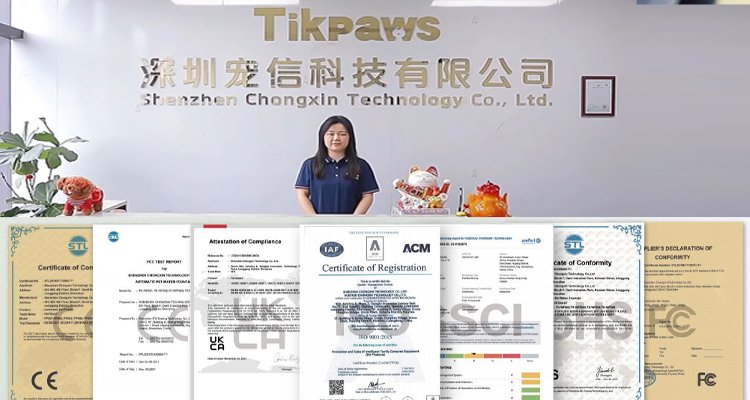
CE and FCC for Smart Pet Products
For products destined for Europe and the US, CE and FCC certifications are essential. These certifications confirm that your products meet safety, electromagnetic compatibility, and environmental standards required in these markets.
Detailed guidelines are available on the official European Commission CE marking page and the FCC official website.
For an in-depth exploration of CE compliance specifically for smart pet products, the resource CE Certified Smart Pet Products: Compliance Requirements for Importers provides actionable insights that help you stay on the right side of regulations.
Importer Risks Without Proper Certification
Operating without verified certifications carries serious risks: shipments may be rejected at customs, fines can be imposed, or e-commerce platforms may remove listings entirely.
These pitfalls can stall growth, erode customer trust, and increase operational costs. Taking the time to verify certificates upfront safeguards your investment and reputation.
Factory Audit Tips for OEM ODM Private Label Smart Pet Products Projects
Auditing your manufacturing partners is another critical step in ensuring quality and compliance. A thorough audit covers production capabilities, quality control processes, and documentation for certifications.
Engaging in this process helps identify potential risks early, ensuring that the products you source not only meet standards but also reflect your brand’s commitment to reliability and excellence.
By connecting compliance checks with factory audits, brands can build a seamless, trustworthy supply chain, laying the groundwork for a successful OEM, ODM, or private label smart pet products launch.
Cost Factors in OEM, ODM & Private Label Smart Pet Products
Understanding the costs behind smart pet product manufacturing is essential for making informed decisions and protecting your brand’s reputation.
Every choice—from materials to certifications—affects your bottom line and the perceived value of your products.
Thoughtful planning at this stage can save time, reduce unnecessary expenses, and prevent costly mistakes later.
Key Pricing Drivers in Smart Pet Product Manufacturing
The final price of a smart pet product is shaped by multiple factors:
- Materials and Components: Premium ABS plastics or BPA-free, food-grade materials are more expensive than generic alternatives, but they elevate product safety and consumer trust. For example, a smart water fountain using stainless steel and BPA-free plastics may cost 20–30% more upfront, but it often attracts higher-end buyers willing to pay a premium.
- Mold and Tooling Fees: Custom molds for unique feeder shapes or litter box designs can be a significant one-time investment. An OEM buyer might spend $1,000–$5,000 on mold fees, depending on complexity. Planning your production volume carefully ensures that this investment is amortized efficiently.
- Certifications and Compliance: CE, FCC, FDA, and RoHS certifications not only protect your customers but also unlock access to global markets. Skipping these may reduce upfront costs but can lead to import delays, fines, or brand damage.
For a detailed breakdown of pricing influences, explore Smart Pet Product OEM Pricing: What Factors Impact Cost in 2025.
Subtle tip: Ask your factory for cost breakdowns by material, electronics, and certification. Transparent costing helps identify potential areas for savings without compromising quality.

Negotiating Bulk Order Discounts
Larger orders typically come with volume discounts, but successful negotiation requires preparation.
For instance, one brand sourcing 5,000 units of a smart feeder from a Chinese OEM negotiated a 12% discount simply by committing to a slightly longer lead time and agreeing to a partial upfront payment.
Another practical approach is tiered ordering: place a smaller initial order to test quality, then gradually increase quantities to unlock bulk savings. Smart planning here prevents overstock while still leveraging economies of scale.
Learn more negotiation strategies in Bulk Order Smart Pet Products: Negotiation Tips & Cost-Saving Strategies.
Subtle tip: Maintain open communication with your OEM/ODM smart pet products partner. Sharing your budget and quality priorities often encourages factories to offer flexible solutions or suggest alternative materials that reduce costs without sacrificing reliability.
Balancing Cost and Quality in Smart Pet Product Imports
Investing wisely in quality safeguards your brand’s reputation.
For example, an OEM smart feeder with a slightly higher-grade sensor and durable motor may cost $3–5 more per unit than a basic model, but it drastically reduces returns and negative reviews.
Similarly, choosing BPA-free plastics or food-grade silicone for feeders or fountains ensures customer trust, even if material costs are higher.
Subtle tip: Perform sample testing and small-scale pilot runs before committing to large orders. This helps validate durability, performance, and app connectivity, minimizing costly surprises after mass production.
Real-world insight: Many successful brands start with a limited SKU and refine design or features based on user feedback. This iterative approach allows you to control costs, test market demand, and gradually scale production without compromising quality or customer satisfaction.
By understanding the interplay of materials, production, certification, and negotiation strategies, OEM/ODM buyers can make smarter decisions, maintain product quality, and protect brand reputation while staying competitive in the growing smart pet product market.
Step-by-Step Importer’s Checklist
Successfully bringing a smart pet product to market starts with a clear, structured approach. Each step builds on the previous one, helping importers navigate complexities, reduce risk, and ensure the final product aligns with both brand vision and customer expectations.
Define Your OEM, ODM or Private Label Smart Pet Product Strategy
Begin by clarifying the type of manufacturing model that best fits your goals—whether that’s fully customized solutions, partial modifications, or simply applying your brand to an existing design. Understanding this early ensures alignment with your budget, timeline, and product differentiation goals.
For more detailed insights on selecting the right approach, take a look at OEM vs ODM for Smart Pet Products: Choosing the Right Model in 2025. This resource can help you weigh the benefits of each model in a real-world business context.
Request Samples and Verify Compliance
Once the strategy is in place, the next step is to see the product firsthand. Obtaining samples allows you to evaluate build quality, functionality, and compatibility with your brand standards.
At the same time, running compliance checks ensures that your product meets safety and regulatory requirements across target markets. Integrating this verification step early prevents costly revisions later and builds confidence in your supplier partnership.
Finalize Production and Ensure Quality Control
With strategy confirmed and samples approved, production planning becomes the focus. Negotiate terms, establish clear timelines, and define quality control checkpoints that safeguard consistency throughout the manufacturing process.
This structured oversight guarantees that each unit meets expectations, protects brand reputation, and ultimately supports a smooth launch to the market.
By approaching each stage thoughtfully, importers can transform complex sourcing processes into a streamlined journey—turning innovative ideas into high-quality smart pet products ready for global distribution.

Unlock Smart Pet Product Success with OEM ODM Private Label Solutions
2025 presents a unique moment for importers and brand owners to tap into the fast-growing smart pet product market.
Thoughtful decisions around choosing the right OEM, ODM, or private label model, combined with reliable factory partnerships and carefully planned customization and compliance strategies, can give your brand a strong competitive advantage.
By requesting samples, verifying certifications, and exploring tailored smart pet product solutions, you can confidently bring innovative feeders, litter boxes, and water fountains to market—products that truly resonate with modern pet owners.
Petrust® has been supporting global brands with smart, high-quality pet technology for years, offering flexible OEM and ODM options to help brands scale efficiently.
Working with an experienced partner like Petrust® ensures that every product meets international standards while reflecting your unique brand vision, turning opportunities in 2025 into tangible growth.
FAQs
1. What’s the difference between OEM and ODM for smart pet products?
OEM allows full customization according to your brand’s design and specifications, offering complete control over features, materials, and branding.
ODM, on the other hand, provides pre-designed products with limited modifications, which can speed up time-to-market but may restrict differentiation.
Knowing which approach aligns with your goals is key to planning a successful launch.
2. Is private labeling smart pet products profitable in 2025?
Private labeling can be a cost-effective way to enter the market quickly with minimal upfront investment. It works best for brands that prioritize speed and efficiency, though unique differentiation may be limited compared to fully customized OEM products.
Pairing private labeling with thoughtful marketing strategies can still create strong brand value.
3. What certifications are required for importing smart pet tech into the EU or US?
Products must meet CE, FCC, and RoHS standards, while FDA compliance is necessary if the product comes into contact with food or water.
Ensuring proper certification not only secures market access but also builds trust with customers who value safety and reliability.
4. How much does OEM smart pet product customization cost in China?
Costs depend on product complexity, order volume, materials, and certification requirements.
For small batches, typical minimums start around 50–200 units, making it accessible for startups and emerging brands looking to test the market.
Understanding these variables helps you plan both budget and strategy effectively.
5. How can importers ensure quality when working with Chinese factories?
Quality assurance requires a hands-on approach. Conduct thorough factory audits, request and test samples, verify certifications, and implement quality checkpoints throughout production.
Maintaining this level of oversight ensures that your smart pet products meet both regulatory standards and customer expectations.

